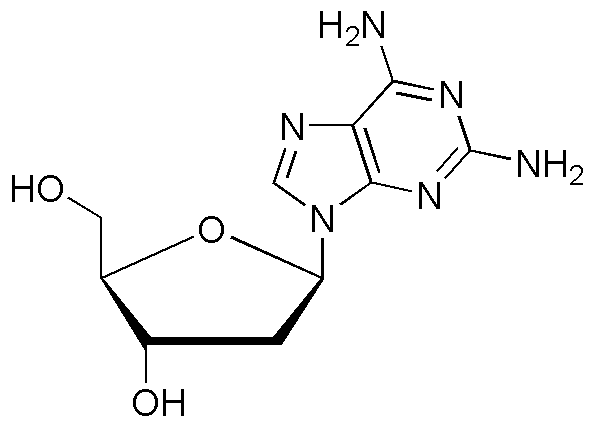2,6-Diaminopurine-2'-deoxyriboside is widely utilized in research focused on:
- Antiviral Research: This compound is being explored as a potential antiviral agent, particularly against viruses that affect the immune system. Its structural similarity to nucleosides allows it to interfere with viral replication.
- Genetic Studies: Researchers use it in studies involving DNA and RNA synthesis, helping to understand genetic processes and mutations. Its incorporation into nucleic acids can provide insights into genetic stability and expression.
- Pharmaceutical Development: The compound is being investigated for its potential as a therapeutic agent in treating various diseases, including cancer. Its unique properties may offer advantages over traditional nucleoside analogs.
- Biochemical Assays: It serves as a substrate in enzymatic assays to study the activity of specific kinases and polymerases, aiding in the development of new drugs and understanding enzyme mechanisms.
- Cell Culture Applications: This compound is used in cell culture media to promote the growth of specific cell lines, enhancing research in cellular biology and drug testing.
General Information
Properties
Safety and Regulations
Applications
2,6-Diaminopurine-2'-deoxyriboside is widely utilized in research focused on:
- Antiviral Research: This compound is being explored as a potential antiviral agent, particularly against viruses that affect the immune system. Its structural similarity to nucleosides allows it to interfere with viral replication.
- Genetic Studies: Researchers use it in studies involving DNA and RNA synthesis, helping to understand genetic processes and mutations. Its incorporation into nucleic acids can provide insights into genetic stability and expression.
- Pharmaceutical Development: The compound is being investigated for its potential as a therapeutic agent in treating various diseases, including cancer. Its unique properties may offer advantages over traditional nucleoside analogs.
- Biochemical Assays: It serves as a substrate in enzymatic assays to study the activity of specific kinases and polymerases, aiding in the development of new drugs and understanding enzyme mechanisms.
- Cell Culture Applications: This compound is used in cell culture media to promote the growth of specific cell lines, enhancing research in cellular biology and drug testing.
Documents
Safety Data Sheets (SDS)
The SDS provides comprehensive safety information on handling, storage, and disposal of the product.
Product Specification (PS)
The PS provides a comprehensive breakdown of the product’s properties, including chemical composition, physical state, purity, and storage requirements. It also details acceptable quality ranges and the product's intended applications.
Certificates of Analysis (COA)
Search for Certificates of Analysis (COA) by entering the products Lot Number. Lot and Batch Numbers can be found on a product’s label following the words ‘Lot’ or ‘Batch’.
Numéro de catalogue
Numéro de lot/série
Certificates Of Origin (COO)
This COO confirms the country where the product was manufactured, and also details the materials and components used in it and whether it is derived from natural, synthetic, or other specific sources. This certificate may be required for customs, trade, and regulatory compliance.
Numéro de catalogue
Numéro de lot/série
Safety Data Sheets (SDS)
The SDS provides comprehensive safety information on handling, storage, and disposal of the product.
DownloadProduct Specification (PS)
The PS provides a comprehensive breakdown of the product’s properties, including chemical composition, physical state, purity, and storage requirements. It also details acceptable quality ranges and the product's intended applications.
DownloadCertificates of Analysis (COA)
Search for Certificates of Analysis (COA) by entering the products Lot Number. Lot and Batch Numbers can be found on a product’s label following the words ‘Lot’ or ‘Batch’.
Numéro de catalogue
Numéro de lot/série
Certificates Of Origin (COO)
This COO confirms the country where the product was manufactured, and also details the materials and components used in it and whether it is derived from natural, synthetic, or other specific sources. This certificate may be required for customs, trade, and regulatory compliance.


